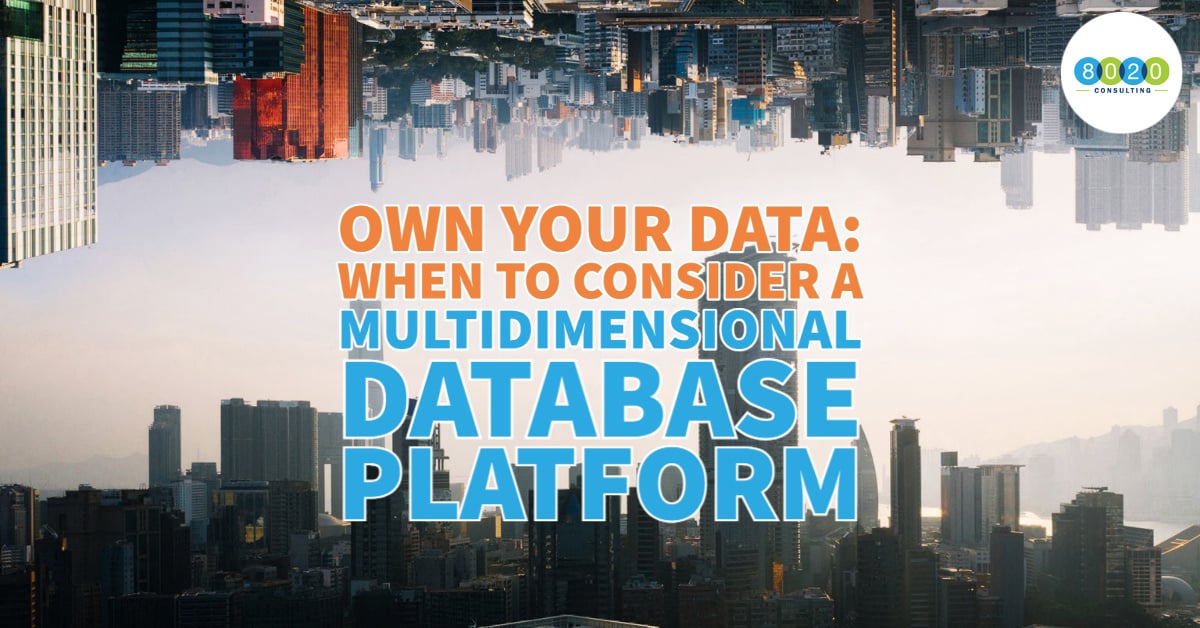The adage “your analysis is as good as your data” is more relevant today than ever before. Technology has enabled us to record and store more data than we can conceivably process. With the increase in the volume of data, one needs a powerful system that can help define, categorize and report on that data seamlessly. This need has led to the emergence of the multidimensional database platform.
The majority of any finance and accounting resource’s time should be spent in data analysis as opposed to data management. But still, managing your data is integral to producing meaningful and impactful analyses.
At a high level, a multidimensional database allows the user to define and categorize the organization’s data into different “dimensions” or “viewpoints.” (For example, a customer account might possess different dimensions such as name, location, account type, etc.) A multidimensional database would tag a customer account with the dimensions listed above and then create different “dimensionality lists,” where you could view your entire customer portfolio categorized into the dimensions listed above (e.g., name, location, account type, etc.). The multidimensional database builds on this key functionality to produce curated automated reports/analyses on demand.
Popular platforms include Microsoft Analysis Services, Oracle Essbase and Cognos Analytics. It is important to note that these platforms are not just smart databases. They also possesses the ability to perform complex calculations and build analytical reports similar to a Business Intelligence (BI) tool.
Who Needs a Multidimensional Database Platform?
Most organizations are using Excel to store large data sets and run resource-heavy calculations and processes. At a high level, if your current data and reporting infrastructure leads to the challenges below, your organization needs an multidimensional database platform:
- Volume of data exceeds current system capabilities and application performance
- Manual processes lead to inefficient use of organization’s headcount and are prone to errors
- Lack of a centralized data repository, leading to data inaccuracy
- Challenges with version management and access control
- Lack of robust management reporting capabilities
- Systems and databases that are not integrated and require manual data migration
What Are the Benefits of a Multidimensional Database Platform?
A multidimensional database platform would offer a range of increased functionality and efficiencies.
Scalability/Data Storage to Support Company Growth
These platforms offer the ability to quickly ingest additional data sets and storage capability without compromising on accuracy or system speed.
User-Friendly GUI That is Customizable to Client Needs
Multidimensional database platforms are extremely user friendly with easy-to-use user interfaces. The user does not have to be an advanced programmer as the GUIs typically allow for simple “drag and drop” functionality allowing for ad-hoc reports to be built on the fly.
Open API Platform for Data Connectivity
These platforms tend to be system agnostic and are open-ended in nature. A good multidimensional database platform can seamlessly integrate with other databases or BI tools.
Access Control (e.g., Admin, Read/Write user, Read users)
The user has absolute access control over the platform. Different access levels can be granted to individuals or organization groups.
Version Control
This function provides the ability to immediately roll back to prior versions. This is an important function especially during the budgeting process, where a budget typically goes through multiple scenarios and versions. Version control also helps the user perform several “what-if scenarios” when forecasting or performing ad-hoc analyses.
Application Performance/Availability With Intricate Calculation Engine
This offers the ability to compute calculations across large data sets that are seamlessly integrated on the back end. The back-end connectivity results in extremely fast performance with minimal system lag.
Ad-hoc Reporting
These platforms offer the ability to drag/drop metrics and attributes for instantaneous reports (similar to Pivot Tables). A non-specialized user can easily create reports in an instant using a drag/drop feature that is standard with all multidimensional database platforms. This negates the need to request the Fintech (Finance Tech) team to create, test and release new reports. The end user has absolute control over the report creation.
Dashboard Reports
Users have the ability to build automated dashboards for KPI reporting (e.g., Sales Performance Metrics, Pipeline Reporting, Executive dashboards). The user can also create reports and perform a data refresh on a chosen timeline (weekly, monthly etc.). These platforms also provide the ability to email dashboards to select recipients, manually or automatically after the initial setup.
Get Support
An efficient multidimensional database platform provides an enterprise-wide system to synchronize your strategy and execution, allowing all your business functions to work in synergy towards achieving the organization’s goals. The collaborative environment, enterprise-level reporting capability, real-time reporting, automated report creation along with other key functionalities make these platforms not a “nice-to-have” but a “must-have” for some organizations in today’s business environment.
If you want support on financial system selection, implementation or optimization in your organization, we invite you to explore our services. Our team of 90+ finance and accounting Consultants can help in a project execution or interim management capacity.

